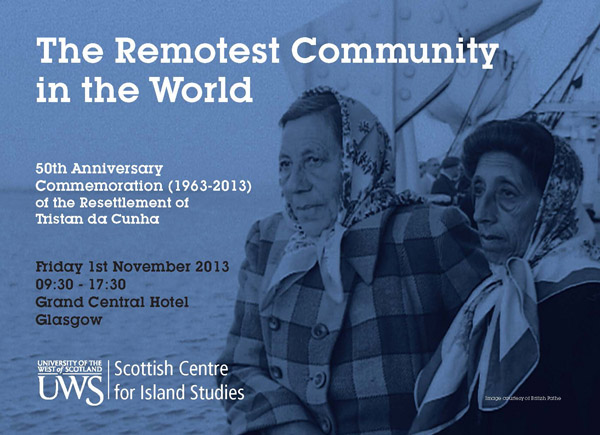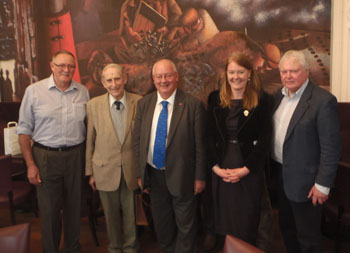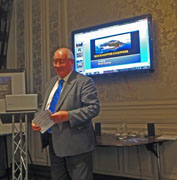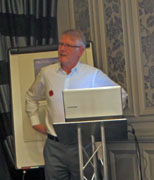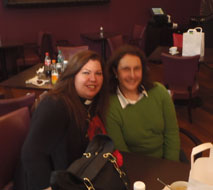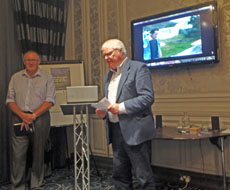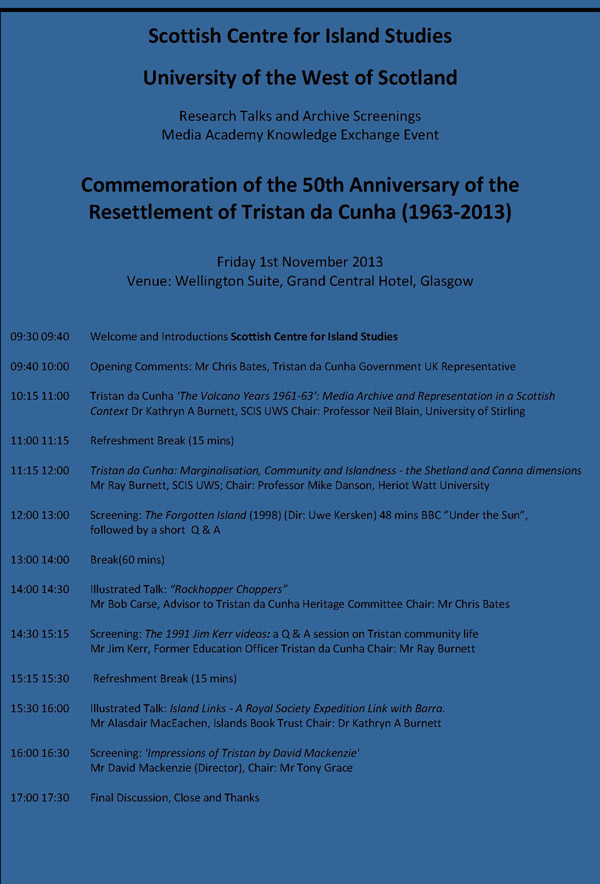Tristan da Cunha Event in Glasgow on 1st November 2013
tristandc.com/ index / glasgowtristan2013event |
Tristan da Cunha Event in Glasgow on 1st November 2013 |
We publish this page on Sunday 10th November 2013
|
|
Report from Richard Grundy It was a privilege to attend the excellent day in the prestigious Grand Central Hotel on Friday 1st November 2013. The event was organised by the Scottish Centre for Island Studies (SCIS) and the University of the West of Scotland (UWS) as a ‘Research Talks and Archive Screenings, Media Academy Knowledge Exchange Event’. The event commemorated the 50th Anniversary of the Resettlement of Tristan da Cunha in November 1963 after the volcanic eruption of 1961 led to the complete evacuation of Tristan Islanders to the UK. The event was fully funded by the UWS, was oversubscribed (nothing like a free lunch!) and almost half of the 50 + present were Tristan Association members. After a welcome and introductions, Tristan da Cunha Government UK Representative Chris Bates opened proceedings by welcoming everyone present of behalf of the Tristan da Cunha Government. He thanked Ray and Kathryn Burnett who had persisted with their plans for a Tristan themed event, originally planned for 2010, and he went on to introduce the island and its early history. By finishing his introduction with the start of the tumultuous events of 1961 Chris set the scene for the rest of the day with appropriate style. |
||||
Left to Right: Tristan Association Secretary Jim Kerr, Tristan Association Chair Michael Swales, |
||||
Professor Neil Blain introduced Dr Kathryn A Burnett, Senior Lecturer in the School of Creative & Cultural Industries , UWS. Kathryn’s presentation was on ‘Tristan da Cunha – The Volcano Years 1961-63 – Media Archive Representation in a Scottish Context’. She highlighted how the media often stereotyped Tristan da Cunha and its Islanders as ‘a problem’ and identified the island community’s culture and traditions as ‘exotic’, emphasised by visual images in films of the time. She compared the Tristan media exposure during 1961-63 with similar coverage of Scottish island communities and explained how the SCIS provided a forum for studies of island communities world-wide. She compared the comparison of the terms ‘remote’ and ‘isolated’ which created immediate impressions on the public which often wrongly labelled communities like Tristan who indeed are isolated, but not remote. During the following discussion Tristan Islander and Tristan Association Vice-Chair Lorna Lavarello-Smith referred to the emotional values of the island refugees and how many resented being regarded as ‘medical specimens’ by the press, partly as they were indeed subjected to detailed medical examination. Tristan Association Chairman Michael Swales recalled how the media sensationalised news items about the islanders during this period. |
||||
|
||||
After a short refreshment break Professor Mike Danson introduced Ray Burnett, SCIS , UWS whose presentation was ‘ Tristan da Cunha: Marginalisation, Community and Islandness – the Shetland and Canna dimensions ’. Ray told us that there were 134 inhabited Scottish islands with a population of 101,000 in 1961, including 27 Orkney and 19 Shetland Islands with a total population of over 36,000. He referred to St Kilda, voluntarily evacuated in 1930, as the ‘ghost in the room’, still haunting Scotland, and how this perhaps set the scene for an immediate Scottish response to the enforced volcanic evacuation of Tristan in 1961. Ray outlined how authorities in the Shetlands made an immediate offer to the UK Colonial office to consider Tristan Islanders settling there, of other possible Scottish locations for the refugees, and of a visit by Gordon Glass to Kelso and Shetland, sponsored by the Scottish Daily Mail. Before lunch we sat back and enjoyed the 1998 BBC film ‘ The Forgotten Island’, directed by Uwe Kersken and broadcast in the ‘Under the Sun’ series. Many of us had seen the film before, but in this context it was special. The narrator Elaine Mawer (nee Repetto) was taking her young son Andrew back to Tristan from Glasgow for a visit and the film showed her emotional reunion with her own friends and family. Unfortunately Elaine, still living locally, was working on Friday morning, but she, Andrew and husband Charlie came in time for lunch and the remainder of the day became even more special as her family had joined us. After lunch Chris Bates introduced fellow Tristan Association member Bob Carse from Dundee who made twelve visits to Tristan between 1996 and 2012 as a Dental Technician, so his presentation was aptly entitled ‘Rockhopper Choppers’. Bob’s many visits over sixteen years has given him a real insight into the Tristan community and he recalled many unusual aspects of his work, from helping create an accurate leg cast to producing safe candle holders from surplus dental plaster. Bob also told us about how he helped form a Tristan Heritage Committee and regular pensioner’s gatherings. |
||||
|
||||
Ray Burnett introduced Tristan Association Secretary Jim Kerr who is the longest serving expatriate to have worked on Tristan da Cunha, working as Senior Teacher and Education Officer from 1985-1991 and as Education Adviser 2009-2012. Jim showed us his Tristan film shot during both sojourns on the island. The film was made as a result of collaboration between Jim and the SCIS through Ray Burnett who provided Jim with digital cameras for pupils to shoot the modern sequences, and organised the digitisation of Jim’s earlier 16mm ‘home movies’. The result is a precious archive which showed a wide spectrum of island life: farming; preparing woollens; one of the last traditional longboat trips to Nightingale Island; special island events and Jim’s work with pupils. Altogether Jim provided a brilliant insight into island life demonstrating how wise the Tristan Islanders were to return to their volcanic island 50 years ago. After tea Kathryn Burnett introduced another Tristan Association member Alasdair MacEachen, Chair of the Islands Book Trust, who showed slides taken by Donald Baird who was the Zoologist on the Royal Society Expedition to Tristan which made the first scientific assessment of the volcanic eruption and its effects between January and March 1962. Tony Grace introduced the prominent Scottish film director David MacKenzie who went to Tristan on the 2010 SA Agulhas trip and showed an atmospheric film he shot showing the island and interviews with islanders. David plans to return to Tristan, first with his family in 2014 or 2015 to write a script for a future fiction film in collaboration with islanders, and then to return later with a film crew to make a film. Chris Bates led thanks to the organisers, sponsors, presenters and those attending. Perhaps the most important part of the day for us all was meeting and creating links with others. So many of us retired to the hotel bar ‘Champagne Central’ where friendship flourished as we looked back on an extraordinary day and forward to future reunions centred on our interest in Tristan. To conclude Kathryn Burnett presented Chris Bates with a bottle of Malt Whisky and an engraved commemoration glass bowl to be presented to the community of Tristan da Cunha when Chris returns to the island aboard the RMS St Helena later in th emonth. |
||||
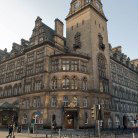 |
About the Glasgow Grand Central Hotel |
|||
The Full Event Programme
|
||||

